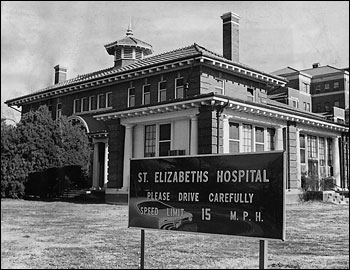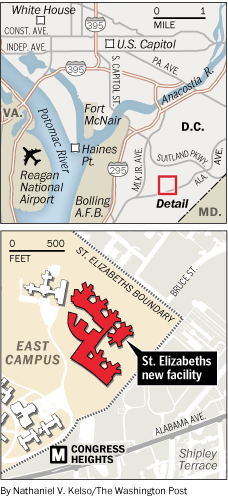New building could mark new era for St. Elizabeths Hospital
By Henri E. Cauvin
Monday, April 19, 2010
Source: Washington Post Staff Writer
From a single structure in 1855, it grew into a campus of more than 130 buildings in Southeast Washington. It was, by the early 20th century, known as St. Elizabeths, for the colonial land grant on which it was built, and it had become, in the words of an admirer, one of the "great, grand" dames of American psychiatric hospitals. Today, at St. Elizabeths, that tradition is not what comes to mind. Not while wandering among the buildings, where it is difficult to tell which are abandoned and which only seem that way. Not while looking at press and government accounts of patients who endured neglect, abuse and too often a premature end to life.
And certainly not while standing in front of the sleek, angular facade of the hospital's newly constructed home. It is this new building, more than a decade in the works and set to open officially this week, that the District hopes will restore a little of the prestige the hospital knew and help end three decades of court oversight brought on by chronic dysfunction in the District's mental health system.
"The tradition of this place is not what we've heard about in the last 20 years," Patrick J. Canavan, the hospital's chief executive, said as he led a tour of the new building, which sits on the eastern edge of the campus, near the Congress Heights Metro station. "The tradition of this place is the forefront of psychiatry in the world."
Set up to serve residents of the District and members of the armed forces, St. Elizabeths had 7,450 patients in 1945, a year before the military stopped sending service members there. Today, it is home to 317 -- 172 of them committed through the criminal justice system and living in the John Howard Pavilion, and 145 committed through the civil system and living in the Rehabilitation Medical Building.
When the patients begin moving into the new building this month, many will, for the first time, have single rooms. Bathrooms in the 448,190-square-foot hospital will be for use by only one person at a time, affording a measure of privacy and safety unknown in the communal facilities of the old hospital. And the heating and cooling systems, officials promise, will work.
But the new building, constructed over three years at a cost of $161 million, isn't just about creating a more comfortable setting, officials say. They intend to create a more effective hospital, one focused on stabilizing people's conditions and, wherever possible, preparing them to return to their communities.
"It's a wonderful opportunity for healing," said Department of Mental Health Director Stephen T. Baron, who worked at St. Elizabeths in the 1970s while working on his master's degree in social work at Howard University.
A history of trouble
Since he was appointed in 2006, Baron has helped engineer improvements in the city's long-troubled mental health system, which has been the subject of a federal class-action suit since 1974. For the first time in many years, an end to the case appears within reach, but with the District proposing to cut nearly 10 percent of the Department of Mental Health's budget, a court monitor has worried publicly that the agency's efforts could be set back.
Fixing St. Elizabeths, which the city inherited from the federal government in 1987, is a crucial piece of that change. It has not been accredited by the Joint Commission, a national body, since 1988. Even though it became clear in the 1990s that a new hospital was needed, ground wasn't broken until Dec. 19, 2006. In the meantime, problems in patient care deepened.
In the most damning inquiry of recent years, the Justice Department documented what it said were widespread civil rights violations stemming from an excessive number of assaults, a lack of adequate psychological and psychiatric services, and failure to ensure adequate discharge planning and placement.
Canavan, a psychologist who had worked at St. Elizabeths in the 1990s, was installed as the hospital's chief with a mandate to turn it around. In 2007, the city reached a settlement agreement with the Justice Department. As he has watched the new building go up and contemplated the hospital's future, Canavan has been looking, he said, to the hospital's past. "We're going back to our roots," he said.
The world of psychiatry, though, has changed since 19th-century reformer Dorothea Dix helped create the Government Hospital for the Insane. Set on an idyllic perch overlooking the Anacostia and Potomac rivers, it was typical of the vast, verdant asylums championed by Dix. The Civil War sent thousands of servicemen to the hospital, and the Spanish-American War and the two world wars would send thousands more, filling buildings faster than they could go up and fueling research that would shape psychiatric practice across the country.
Such institutions have long since become anachronisms, emptied of most of their patients in the push to treat the mentally ill outside hospitals. Drugs that did not exist in earlier eras seemed to make that possible, and the Community Mental Health Act of 1963 helped to make it law. But for the many patients who ended up in jail or on the streets, deinstitutionalization was a failure. Communities were unprepared for the flood of people and have been struggling to cope since.
Over the past several years, the District has been trying to remake the city's mental health system. Private hospitals and organizations now provide much of the mental health care, and St. Elizabeths is supposed to serve a smaller but still significant role as the provider of last resort. Even then, the objective is to help people return to the community by making them an integral part of their therapy.
"We're really shifting a paradigm here to say that your job, when you're in the hospital, is treatment," Canavan said.
A place for treatment
In ways large and small, the new building is designed for that. Instead of shuttling among more than a dozen buildings for meals, treatment and medical care, patients will be able do almost everything in the new building. That will allow patients and staff members to devote more energy to treatment.
For patients having a difficult day, the treatment areas will have escapes, such as a comfort room with soft music, blankets and hot stones. Patients will be able to regroup without going back to the living unit and losing a day of treatment, Canavan said.
Because patients are more likely than ever to be discharged, the hospital is set up to try to keep them connected to the communities they've left or reintroduce them to communities they've forgotten.
The Activities of Daily Living Apartment, or the Apartment, will allow patients to learn hands-on how to live in a modern home. It has a stove that cooks, a toilet that flushes and a washing machine that washes, in contrast to the old apartment, which had a box for a toilet and didn't try to approximate a stove or a washing machine.
Encouraging autonomy wherever possible, Canavan said, was an essential part of the plan for the hospital, which was designed by Einhorn Yaffee Prescott, a firm that has worked on mental health facilities in Maryland, Virginia and elsewhere.
Many of the wings in the new building have small, enclosed courtyards. Rather than having to be chaperoned for a breath of fresh air, patients will be able to ask the staff to buzz open the door to the courtyard, where they can be observed from the nursing station. Outside, they will find themselves in a little patch of greenery -- with plants whose branches are too small to support the weight of a body were a person to attempt suicide or an escape.
The move to the new building is monumental by almost any measure, and for some of the patients, the prospect has been fraught with anxiety.
"You can see it in people's eyes," said Samuel Awosika, who was a patient for about three years in the 1990s and now works for the hospital as an advocate for patients. "They have a lot of questions and concerns." But as Awosika and other advocates have met with patients, concerns have given way to excitement. "They love that it's a new building," he said.
By the end of the year, the number of patients is expected to fall to 293, the capacity of the new hospital, as more patients are moved into the community. The U.S. Department of Homeland Security has begun building its new headquarters on the oldest part of the hospital compound, on the western side of what was once called Asylum Road and is today Martin Luther King Jr. Avenue. On the eastern side of the compound, plans are in the works for the city to redevelop much of the land.
The St. Elizabeths name will remain. But the hospital that once spanned more than 300 acres, that housed poet Ezra Pound and still houses presidential assailant John W. Hinckley Jr., will in many ways be history, memorialized in a small museum just beyond the facade of its striking new home.
The new building won't bring back what was great about the old St. Elizabeths, but the modern facility could be a crucial step in creating a St. Elizabeths for a new era, said Steven S. Sharfstein, a psychiatrist who leads one of Maryland's biggest mental health providers, Sheppard Pratt Health System.
"Maybe it's not the grand dame anymore," Sharfstein said, "but maybe it can be the young prince of public psychiatry."

